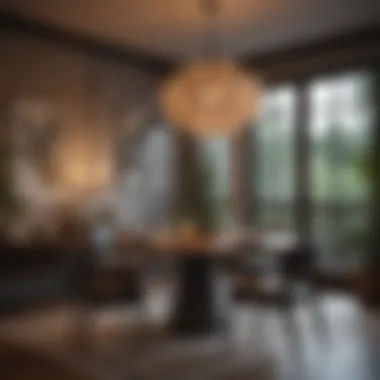Cosmo Perennial: Redefining Home Aesthetics


Intro
The concept of cosmo perennial merges the principles of timeless design with cosmopolitan influences. This approach emphasizes creating spaces that are not only aesthetically pleasing, but also functional and reflective of diverse cultures. It invites homeowners to reevaluate how they interact with their environment, aiming for harmony and beauty in daily living.
Understanding cosmo perennial is essential for anyone interested in home aesthetics, gardening, or entertaining. It encapsulates a holistic perspective that transcends superficial trends. As we explore this concept, we'll uncover valuable insights that can transform living spaces into personal sanctuaries.
Key Insights and Trends
Current trends in interior design
The contemporary interior design landscape is rich with diverse influences. In recent years, a few key trends stand out in the realm of cosmo perennial:
- Sustainable materials: Homeowners increasingly favor eco-friendly materials. Bamboo, reclaimed wood, and recycled metals are just a few examples of how sustainability is shaping aesthetic choices.
- Global decor: Collecting pieces from various cultures helps create unique interiors. This trend encourages mixing styles, such as combining Scandinavian minimalism with traditional African textiles.
- Biophilic design: Integrating nature into home interiors is gaining popularity. This may include large windows, indoor plants, and natural light, promoting a connection to the outside world.
Popular gardening techniques of the season
Gardening aligns seamlessly with the cosmo perennial philosophy. Current techniques focus on sustainability and biodiversity:
- Vertical gardening: Ideal for urban spaces, vertical gardens utilize limited space efficiently. They can host an array of plants, enhancing aesthetics while promoting green living.
- Perennial plants: Choosing native and perennial species fosters local ecosystems. These plants require less maintenance and offer year-round beauty.
- Companion planting: This technique involves growing compatible plants together to enhance growth. It improves yield and creates a balanced garden environment.
Practical Tips and How-To Guides
Step-by-step guides for home decoration projects
Transforming your space can be a fulfilling endeavor. Here’s a simple guide to refresh your home:
- Identify your style: Consider which elements resonate with you. Compile inspiration images or mood boards that reflect your taste.
- Declutter: Remove items that do not contribute to your desired aesthetic. Focus on quality over quantity.
- Choose a color palette: Select a harmonious color scheme. Neutral tones with bold accents can create a balanced look.
- Invest in key pieces: Focus on quality furniture or art. These will serve as the foundation for your décor.
- Accessorize thoughtfully: Use decor that reflects your personality and interests. This adds depth to your honored aesthetic.
Entertaining tips and planning checklists
Creating a welcoming environment for guests requires both planning and attention to detail. Here’s how to make entertaining seamless:
- Set a theme: Decide on a theme that complements your home’s aesthetic, whether it’s formal or casual.
- Plan your menu: Consider dietary restrictions and preferences. A well-curated menu enhances the overall experience.
- Create a checklist:
- Invitations: Send them out in advance.
- Seating arrangements: Ensure comfortable seating for all.
- Ambiance: Adjust lighting and background music to set the mood.
A home built on the principles of cosmo perennial reflects not just personal style, but also an appreciation for the world’s cultural diversity.
Understanding Cosmo Perennial
The notion of cosmo perennial intertwines various principles that guide the aesthetics of our living spaces. As we seek to create environments that are not only visually appealing but also functional and sustainable, understanding this concept becomes essential. It encourages homeowners and design enthusiasts to explore the balance between beauty and practicality. Different elements come into play, from how we choose materials to the plants we put in our gardens.
Here are some specific elements that highlight the importance of cosmo perennial:
- Timeless Design: Cosmo perennial promotes aesthetics that stand the test of time. Instead of following fleeting trends, it emphasizes durable beauty.
- Sustainable Practices: This concept encourages environmentally-friendly choices in design, fostering a more sustainable way of living.
- Cultural Integration: Home design can be a reflection of diverse global cultures, allowing people to express their identities within their spaces.
Overall, understanding cosmo perennial equips individuals with the insights needed to enhance their home aesthetics while considering functionality and sustainability.
Definition of Cosmo Perennial
Cosmo perennial refers to the fusion of cosmopolitan elements with perennial design principles. To put it simply, it integrates global influences into the timeless aspects of home aesthetics. Perennial here signifies elements that do not fade or go out of style, while "cosmo" alludes to the broader cultural inspirations that inform our designs. This synergy creates spaces that not only resonate with beauty but also tell a story, reflecting the owner’s journey and worldly experiences.
Incorporating cosmo perennial means focusing on quality materials, enduring color palettes, and sophisticated patterns. These may include vintage furniture, natural fabrics, and sustainable items, contributing to an environment that feels both welcoming and personally meaningful.
Historical Context
The concept of cosmo perennial doesn't arise from nowhere. Throughout history, we see influences from various cultures impacting home design.
From the Renaissance's grand aesthetics to the minimalism rooted in Japanese Zen philosophy, every style reflects a combination of time-honored principles and evolving tastes. The mid-20th century marked a shift towards open spaces and functional furniture, which remain relevant today.
In the current context, with increased globalization, design can take cues from various corners of the world. The result is a tapestry of influences merging into personal spaces, fostering a sense of peace and belonging.
"A cosmo perennial space is not just a place; it’s an experience, shaped by the biodiversity of cultures and time."
Understanding the historical context provides insight into how we can enrich our homes today, celebrating the shared human experience while doing so.
Philosophy Behind Perennial Design


The philosophy behind perennial design is integral to the broader understanding of cosmo perennial aesthetics in the home. This concept emphasizes a thoughtful approach to design, merging practicality with timeless beauty. A focus on enduring principles rather than fleeting trends is essential. Homeowners and designers alike can benefit from this perspective, as it promotes spaces that are not only visually appealing but also functional and sustainable.
Enduring Aesthetics
Enduring aesthetics reflect the belief that beauty should remain relevant across generations. In home design, this means selecting elements that do not merely adhere to the whims of fashion but instead invoke a sense of lasting appeal. For example, opting for classic furniture styles like the Eames Lounge Chair or neutral color palettes allows for a versatile backdrop that can withstand changes in trends.
By focusing on materials that age gracefully, such as solid wood or natural stone, a space is imbued with a rich character that enhances over time. Elements like these invite a deeper appreciation, resonating with those who value quality and craftsmanship.
"True aesthetics capture the essence of living; they are not just trends but reflections of enduring values."
The use of art and textiles should also align with this philosophy. Art pieces from various cultures, or textiles that tell a story through their patterns, add not only beauty but also depth to a space. This blending of aesthetic appeal with meaningful context creates an atmosphere that remains inviting and inspiring through the years.
Sustainability and Longevity
Sustainability plays a pivotal role in the concept of perennial design. It involves the conscious selection of resources and practices to minimize environmental impact. Homeowners are increasingly aware of the choices they make, opting for materials and processes that reflect a commitment to sustainability.
Incorporating elements like recycled materials, energy-efficient appliances, and sustainable landscaping practices is key. These choices ensure that spaces remain functional while fostering an appreciation for the environment. Designing interiors that emphasize natural light not only reduces energy use but also increases well-being.
Longevity in design can be achieved through several approaches:
- Durable materials: Materials like bamboo, which is both sustainable and strong.
- Timeless designs: Classic architectural styles that remain appealing and functional over time.
- Low-maintenance solutions: Such as perennial plants that require less water and care, aligning with both aesthetics and practicality.
Through these considerations, homeowners can achieve a harmonious balance of beauty, sustainability, and practicality. The philosophy of perennial design encourages investment into spaces that not only please the eye but also honor the earth, enhancing the overall quality of life.
Cosmopolitan Elements in Home écor
Creating a home that reflects a cosmopolitan aesthetic involves incorporating a variety of global influences and styles. Such an approach not only enriches the living space but also creates a narrative that engages and inspires. By blending different cultural elements and materials, homeowners can achieve an atmosphere that is both unique and welcoming. Understanding these cosmopolitan elements can shape the overall aesthetic and functionality of a home.
Cultural Influences
Cultural influences play a pivotal role in home décor. Each culture has its own visual language, often created by centuries of tradition, innovation, and environmental adaptation. For instance, incorporating Mexican talavera tiles can add a pop of color and intricate designs, while Japanese shoji screens can provide a minimalist touch that emphasizes natural light.
Integrating these elements allows a homeowner to reflect their personal experiences and appreciation for diverse cultures. It also serves as a conversation starter, inviting guests to engage with the stories behind each piece.
Key considerations when blending cultural items include:
- Authenticity: Ensure that the items are genuine and not just facsimiles. This appreciation lends authenticity to the décor.
- Balance: Avoid overwhelming a space with too many cultural motifs. Strive for a balanced feel that promotes unity among the various influences.
- Context: Understand the context within which each piece exists. This helps in arranging items without losing their cultural significance.
Diverse Materials and Textures
The importance of choosing diverse materials and textures cannot be overstated. Using a variety of surfaces – from rustic wood to polished stone, or even soft fabrics to metallic accents – can evoke different sensations within a space. Unity in diversity allows for a dynamic blend that engages the senses.
Integrating materials like reclaimed wood can bring warmth, while a glass table adds modern elegance. By strategically layering materials, the space tells a story of creativity and exploration.
Consider the following:
- Natural Elements: Incorporate organic materials such as bamboo, jute, or clay. They enhance the connection with nature.
- Contrasting Textures: Mix hard surfaces with softer ones. A rough stone wall, paired with plush throw pillows, creates visual interest and comfort.
- Sustainable Choices: Opt for materials that are eco-friendly. Bamboo and recycled metals offer style while being kind to the environment.
"Diverse materials create a living atmosphere, giving each space a unique personality."
Integrating these cosmopolitan elements into interior design enriches the aesthetic and provides an opportunity for storytelling. Homeowners can personalize their spaces, reflect their global experiences, and promote an appreciation for the diverse world we inhabit.
Integrating Cosmo Perennial into Interior Design
Integrating Cosmo Perennial into interior design represents a harmonization of beauty and utility that resonates deeply with the modern homeowner. This concept transcends mere aesthetics; it embodies a lifestyle and philosophy that enhances the way we perceive and inhabit our spaces. In an increasingly globalized world, where culture and ideas intermingle, incorporating perennial principles into our homes encourages a thoughtful selection of elements that are both timeless and reflective of diverse influences.
The importance of this integration lies in its emphasis on sustainability, functionality, and an enduring appeal. When applied thoughtfully, Cosmo Perennial principles can lead to spaces that not only stand the test of time but also bring comfort and joy to their inhabitants. The following subsections will explore critical aspects of this integration:
Color Palettes
Choosing the right color palette is a vital step when integrating Cosmo Perennial into your interior design. Color can dramatically affect mood and atmosphere within a home. Therefore, selecting hues that are both calming and conducive to relaxation is of great importance. Earthy tones, muted pastels, and rich neutrals generally embody the Cosmo Perennial aesthetic. They provide a versatile backdrop that allows for cultural accents and seasonal changes without feeling overwhelming.
- Consider using colors inspired by nature.
- Balance warm and cool shades to create harmony.
- Use accent colors to reflect cultural inspirations.
These strategies ensure that color choices support a coherent narrative in your home, linking its aesthetic to the broader cosmo perennial philosophy.
Furniture Selection


The process of furniture selection is crucial within the framework of integrating Cosmo Perennial. It is essential to choose pieces that prioritize functionality while also being aesthetically appealing. Furnishings should embody durability and versatility, able to adapt to a variety of uses and styles.
- Opt for timeless designs that offer both comfort and style.
- Incorporate sustainable materials like reclaimed wood or natural fibers.
- Mix and match influences from different cultures to create unique focal points.
By focusing on these aspects, you enhance the aesthetic appeal of your home while embracing a design that is inherently grounded in the principles of the Cosmo Perennial.
Space Planning
Effective space planning is another key element in integrating Cosmo Perennial into interior design. This requires a meticulous approach to how each area is utilized within the home. A thoughtful layout promotes ease of movement and encourages social interactions, both of which are essential for a harmonious living environment.
- Create distinct zones for different activities such as relaxation, work, and entertaining.
- Ensure there is ample natural light to enhance the ambience of each space.
- Maintain a balance between open spaces and cozy nooks, allowing for both togetherness and solitude.
Space planning not only deepens functionality but also enriches the overall aesthetic, truly embodying the ideals of Cosmo Perennial design.
"Incorporating Cosmo Perennial into your home is not just about aesthetic choices; it represents a holistic approach to designing spaces that nurture and inspire."
By focusing on these three aspects — color palettes, furniture selection, and space planning — homeowners can create environments that feel both timeless and dynamic. The essence of Cosmo Perennial in interior design pivots around a careful balance where every decision contributes to an ongoing dialogue between culture, sustainability, and personal expression.
Gardening with a Cosmo Perennial Mindset
Gardening with a cosmo perennial mindset emphasizes creating sustainable and harmonious outdoor spaces that reflect a connection to both nature and cultural diversity. This approach is significant as it not only beautifies homes but also contributes positively to the environment. By integrating plants and designs from various cultures, homeowners can cultivate gardens that tell a story, foster biodiversity, and provide personal enjoyment.
This practice encourages a thoughtful selection of plants that thrive in local climates while having the ability to flourish year after year. Additionally, a cosmo perennial garden nurtures the ecosystem, supports local wildlife, and promotes a sense of peace and balance in everyday life.
Selecting Perennial Plants
Choosing the right perennial plants is vital in achieving a lush and low-maintenance garden. Perennials return each year, offering both economic benefits and ecological advantages. Here are some important considerations for selecting perennial plants:
- Local Adaptation: Prioritize plants that are native to your region. They are typically more resilient to local pests and require less water once established.
- Diversity: Select a variety of plants to promote biodiversity. Mixing colors, heights, and blooming seasons ensures visual interest throughout the year.
- Sustainability: Consider plants that are drought-resistant or require minimal maintenance. This reduces the need for excessive watering or chemical fertilizers.
- Cultural Significance: Incorporate plants that reflect cultural heritage or personal history. For example, using herbs like rosemary could nod to Mediterranean roots.
Cultural Garden Designs
Cultural garden designs showcase the unique influences of various traditions and practices around the world. When planning a garden with this perspective, it is important to keep certain aspects in mind:
- Design Themes: Research different garden styles such as Zen gardens, Mediterranean terraces, or traditional herb gardens. Each theme tells a story and brings a sense of identity to your garden space.
- Materials: Use materials in your garden that reflect global influences. Stones, pathways, and ornaments can mirror cultural aesthetics, enhancing the overall theme.
- Plants with Traditions: Integrate culturally important plants, such as lotus flowers in an Asian-inspired design or native wildflowers to reflect heritage.
- Sustainability Principles: Look at historical practices that promote sustainability. For instance, permaculture principles that mimic natural ecosystems can be a valuable guide.
"Gardening with a cosmo perennial mindset is not just an approach; it’s a journey toward creating a cohesive space that resonates with personal and cultural significance."
The Role of Entertaining in Cosmo Perennial Living Spaces
The concept of cosmo perennial extends beyond aesthetics to encompass how spaces are utilized, particularly for entertaining. In this context, hosting gatherings becomes a vital aspect of home life, creating a sense of community and connection. Entertaining plays a significant role in the overall experience of a home, transforming a mere living space into a warm and welcoming environment. Such spaces not only serve functional purposes but also are seen as a reflection of the inhabitants’ values and style.
Creating Inviting Environments
To establish an inviting environment, thoughtful design choices are essential. The goal is to make guests feel comfortable and appreciated. Here are some key elements to consider:
- Seating Arrangements: Ensure there is enough seating for guests without crowding the space. Modular furniture like sectional sofas can be reconfigured for different occasions.
- Warm Lighting: Soft lighting creates an intimate atmosphere. Consider using floor lamps, table lamps, or candles to enhance the mood.
- Open Spaces: Keep pathways clear and areas open to encourage movement. A clutter-free environment invites guests to explore different sections of the room.
- Personal Touches: Incorporate elements that reflect your personality and culture. Art pieces, photographs, or unique artifacts can be great conversation starters.
Environments that prioritize comfort and aesthetics become more than just locations for gatherings—they become memorable experiences for both hosts and guests.
Conceptualizing Themed Gatherings
Themed gatherings offer a unique way to engage guests and create shared experiences. By establishing a cohesive theme, hosts can enhance the aesthetic appeal of their cosmo perennial spaces. Here are some ideas to conceptualize gatherings effectively:
- Cultural Celebrations: Host events centered around cultural festivals or traditions. This allows for the inclusion of specific foods, decorations, and attire that reflect diversity.
- Seasonal Themes: An autumn gathering might showcase warm colors, pumpkins, and cinnamon-spiced treats, while summer events could focus on light, bright colors and outdoor settings.
- Interactive Activities: Incorporate engaging activities that align with the theme. Cooking classes or craft stations make gatherings interactive and memorable.
In summary, entertaining in cosmo perennial living spaces can elevate the atmosphere and strengthen social bonds. Thoughtful design and themed gatherings enhance personal connections, showcasing the beauty of well-rounded home aesthetics.
Case Studies of Successful Cosmo Perennial Implementations
In exploring the design language of cosmo perennial, examining real-life applications is an important step. Case studies of successful implementations provide not only inspiration but also tangible evidence of the principles in action. These examples show the effectiveness of integrating cosmopolitan design with perennial aesthetics, allowing homeowners and designers to visualize the potential for their own spaces. They highlight specific elements and benefits that come from such thoughtful integration.
Engaging with these case studies also allows for deeper discussion on design considerations, revealing how diverse influences can create harmonious environments. By analyzing various implementations, we gain insights into trends, philosophies, and overall execution that resonate within today's aesthetic sensibilities.
Residential Examples
Residential examples of cosmo perennial design demonstrate the fusion between functionality and beauty in personal living spaces. Properties that have embraced this concept often feature an eclectic mix of global influences, achieved through decor, furnishings, and even architectural styles.


For instance, a home may incorporate Mid-Century modern furniture alongside traditional Japanese tatami mats, creating an inviting yet intriguing environment.
- Unique Decor Choices: Selecting art and accessories from various cultures can create personal narratives throughout the space.
- Functionality: Efficiently planned spaces maximize comfort, while elements such as natural light and extensive greenery enhance overall well-being.
This blend illustrates how homeowners can create environments that are not only pleasing visually but purposeful in their layout and usability. A hallmark example can be found in homes in urban areas such as San Francisco, where small spaces are transformed through smart design strategies, resulting in stylish yet functional living areas.
Public Spaces and Developments
Public spaces that embody the principles of cosmo perennial design often serve as community hubs. When designed thoughtfully, these areas become more than mere gathering spots; they foster a sense of belonging and connection among diverse populations.
Take the High Line in New York City as an example. This elevated linear park integrates natural landscaping with art installations and seating areas, creating a vibrant space for residents and tourists alike.
- Cultural Representation: From the architecture to the planting design, elements from various cultures are showcased, promoting inclusivity.
- Sustainability: The focus on native plants in gardens encourages biodiversity and ecological health, emphasizing the importance of sustainable practices.
Public parks and mixed-use developments that incorporate these principles often see increased foot traffic and community engagement. They resonate with the concept of cosmo perennial by being adaptable, beautiful, and enriching to their surroundings, embodying the ever-evolving nature of design.
"Examining how cosmo perennial principles manifest in public design illuminates the potential of spaces to foster community and well-being."
Through these case studies, we can see how principles of cosmo perennial are not just theories but actionable pathways that lead to significant improvements in aesthetic and functional aspects of homes and public spaces.
Practical Tips for Homeowners
In the realm of cosmo perennial design, it is essential for homeowners to consider various practical strategies that ensure a coherent and stylish living space. This section focuses on two key areas: budgeting for perennial designs and deciding between DIY efforts or hiring professional assistance. Each aspect carries weight in shaping a space that is both culturally rich and aesthetically pleasing.
Budgeting for Perennial Designs
Budgeting is a critical element when planning any interior or garden space under the cosmo perennial philosophy. Understanding the costs allows homeowners to allocate funds effectively, balancing their aspirations with financial realities.
- Assessing Financial Capacity: Begin with a clear understanding of your financial limits. Knowing your budget helps in making informed choices rather than impulsive purchases.
- Prioritize Key Features: Identify the elements that hold the most significance for your design vision. For instance, if a specific type of perennial plant resonates with the aesthetic you aim to achieve, allocate a larger portion of your budget to it. This prioritization ensures that you invest in items that provide maximum impact.
- Research and Compare Costs: Various suppliers and resources can provide different price ranges. It is wise to gather quotes and understand the market before making final decisions.
- Plan for Longevity: While some may feel tempted to invest in trendy items, perennial designs focus on enduring aesthetics. Spending a bit more on quality pieces that withstand time will save money in the long run.
"Budgeting enables individuals to transform their vision into a tangible reality without undue financial strain."
- Consider Future Costs: Factor in potential maintenance and replacement costs, particularly for plants. While perennials are often low-maintenance, understanding their needs can help avoid unexpected expenses.
The benefits of meticulous budgeting are clear. It reduces stress, enhances creativity, and allows for a thoughtful assembly of elements that embody the cosmo perennial spirit.
DIY vs. Professional Help
When it comes to implementing cosmo perennial concepts, homeowners face a choice between doing it themselves or hiring professional services. Each route has its own merits and considerations, and the decision should reflect individual capabilities and project scope.
- Assess Your Skills: Start by evaluating your abilities in design and gardening. If you are confident in your skills, a DIY approach can be rewarding and cost-effective.
- Understand the Complexity: Some design elements, like intricate color palettes or unique space planning, may necessitate professional expertise. Assess the complexity of your project to determine whether outside assistance will enhance the outcome.
- Consider Time Constraints: DIY projects can be time-consuming. If you have limited time or numerous responsibilities, hiring a professional might be the better choice to ensure your project remains on schedule.
- Learning Opportunities: Engaging in DIY allows for personal growth and a deeper connection with the design process. It can be a gratifying experience, especially in gardening where nurturing plants fosters appreciation.
- Quality of Work: Professionals often bring experience and insight that can prevent costly errors. If aesthetic quality is a top priority, investing in professional help might be worthwhile.
Choosing between DIY and professional help ultimately depends on your situation and comfort level. Each path offers distinct advantages that can lead to a successful cosmo perennial integration in your home.
Future Trends in Cosmo Perennial Design
Future trends in cosmo perennial design point towards innovations that influence both aesthetics and functionality in living spaces. As homeowners increasingly seek environments that reflect their values and lifestyles, understanding these trends becomes essential for creating appealing and enduring settings. The continual intersection of technology, sustainability, and aesthetics is reshaping how we approach interior design and gardening practices.
This section will elaborate on two significant aspects: technological innovations and sustainability practices. Both elements are crucial for homeowners, interior design enthusiasts, gardening aficionados, and party hosts to consider when developing their spaces.
Technological Innovations
Technological innovations are at the forefront of design evolution. These advancements expand possibilities in home aesthetics and functionality. Innovations like smart home devices allow homeowners to manage their environments seamlessly. For instance, smart thermostats can optimize energy usage, enhancing comfort while being energy-efficient.
Key technological innovations include:
- Smart Lighting: Adjustable and programmable lighting systems can help create the desired mood in a room.
- Home Automation: Integration of various systems, such as security and entertainment, simplifies user experience and increases convenience.
- Augmented Reality (AR): AR applications enable users to visualize potential design changes in real-time, making decisions easier.
Using these technologies not only improves accessibility but also encourages sustainable practices by monitoring energy consumption effectively. As households adopt smarter solutions, the potential for enhancing cosmo perennial living spaces grows.
Sustainability Practices
Sustainability practices are increasingly vital in cosmo perennial design. Homeowners are more conscientious about their environmental footprint than ever before. Integrating sustainable materials and practices ensures that spaces remain beautiful while being eco-friendly.
Sustainable practices include:
- Recycled Materials: Using products made from reclaimed materials helps reduce waste and promotes a circular economy.
- Native Plants in Gardening: Selecting plants that naturally thrive in local climates lowers maintenance and resource usage.
- Energy-Efficient Appliances: Incorporating products that save energy not only reduces bills but also conserves resources.
"Incorporating sustainability into home design is no longer a trend; it's a necessity that benefits both the environment and our living spaces."
The convergence of technological innovation and sustainability practices represents a shift towards more thoughtful approaches to interior design and gardening. Homeowners who embrace these trends enhance both the aesthetics and functionality of their spaces while contributing to a sustainable future.
Attending to future trends can thus create environments that are not only beautiful but also resilient and responsible.



